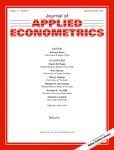
Schwaab, B., Koopman, S. and Lucas, A. (2017). Global Credit Risk: World, Country and Industry Factors Journal of Applied Econometrics, 32(2):296--317.
-
Affiliated authors
-
Publication year2017
-
JournalJournal of Applied Econometrics
We investigate the dynamic properties of systematic default risk conditions for firms in different countries, industries and rating groups. We use a high-dimensional nonlinear non-Gaussian state-space model to estimate common components in corporate defaults in a 41 country samples between 1980:Q1 and s2014:Q4, covering both the global financial crisis and euro area sovereign debt crisis. We find that macro and default-specific world factors are a primary source of default clustering across countries. Defaults cluster more than what shared exposures to macro factors imply, indicating that other factors also play a significant role. For all firms, deviations of systematic default risk from macro fundamentals are correlated with net tightening bank lending standards, suggesting that bank credit supply and systematic default risk are inversely related.